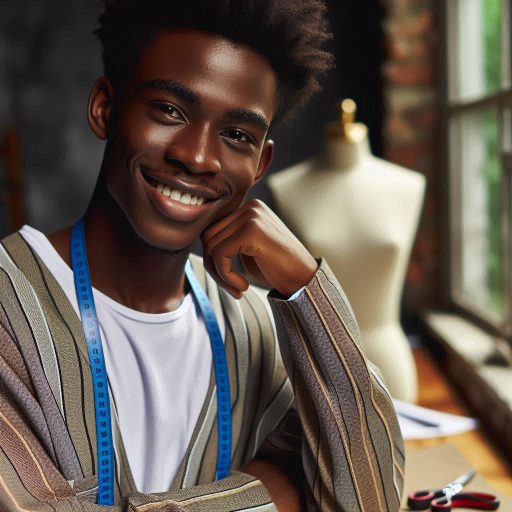Introduction
Costume design plays a crucial role in the entertainment industry.
It helps bring characters to life and enhances storytelling.
Designers use costumes to express characters’ personalities and the world they inhabit.
As technology advances, costume design evolves rapidly.
New tools and methods are revolutionizing the field.
In the past, costume design relied heavily on traditional techniques.
Seamstresses and tailors crafted garments by hand.
Today, technology offers innovative solutions that streamline the process.
Digital tools, such as 3D modeling software, are now integral to designing costumes.
These tools allow designers to create detailed and accurate costume prototypes.
They can visualize designs in virtual spaces before physical creation.
3D printing is another groundbreaking technology.
It enables designers to produce intricate costume pieces quickly.
This technology also allows for experimenting with new materials and textures.
Wearable technology is also transforming costume design.
Designers incorporate smart fabrics and sensors into costumes, adding interactive elements.
Augmented reality (AR) and virtual reality (VR) are making waves in the industry.
AR helps designers visualize costumes on actors in real-time.
VR allows for immersive design experiences and simulations.
These technologies facilitate precise adjustments and enhance creative possibilities.
Transform Your Career Today
Unlock a personalized career strategy that drives real results. Get tailored advice and a roadmap designed just for you.
Start NowOverall, the integration of these technologies is reshaping costume design.
It offers designers new ways to innovate and bring their visions to life.
The future of costume design is bright, driven by continuous technological advancements.
Virtual fitting rooms
How virtual fitting rooms use AR technology to allow costume designers to visualize outfits on digital avatars
Virtual fitting rooms are transforming the costume design industry by leveraging augmented reality (AR) technology.
These innovative tools enable designers to visualize outfits on digital avatars, enhancing creativity and precision.
Virtual fitting rooms use AR to superimpose costumes onto 3D models or avatars.
Designers can see how fabrics, colors, and styles appear in real-time without physical prototypes.
This technology allows for instant adjustments, enabling designers to explore multiple design options quickly.
Benefits of virtual fitting rooms in saving time and costs during the design process
One significant benefit of virtual fitting rooms is time savings.
Traditional fitting processes require multiple fittings with physical garments, which can be time-consuming.
Virtual fitting rooms eliminate the need for these repeated physical trials.
Designers can make adjustments and see results instantly, speeding up the design process.
Cost savings is another advantage. Creating physical prototypes involves material costs, labor, and space.
Virtual fitting rooms reduce or eliminate these expenses by allowing designers to test and refine designs digitally.
This shift leads to more cost-effective design processes and reduces waste associated with physical samples.
Virtual fitting rooms also enhance collaboration.
Designers can share digital avatars and designs with clients and team members globally.
This facilitates quicker feedback and approval, streamlining communication and ensuring the design meets client expectations.
In summary, virtual fitting rooms are a game-changer in costume design.
They use AR technology to visualize outfits on digital avatars, offering significant time and cost savings.
Transform Your Career Today
Unlock a personalized career strategy that drives real results. Get tailored advice and a roadmap designed just for you.
Start NowBy embracing these technologies, designers can work more efficiently and creatively, making the costume design process more dynamic and innovative.
Read: Costume Design for Theater vs. Film
3D Printing
One of the most innovative technologies that have been making waves in the costume design industry is 3D printing.
This cutting-edge technology has revolutionized the way designers create intricate and unique pieces for various productions.
Revolutionizing Costume Design
3D printing has opened up a whole new world of possibilities for costume designers.
By utilizing this technology, designers can bring their wildest imaginations to life by creating intricate and detailed costumes that were once thought to be impossible to make.
With the ability to print in multiple dimensions, designers can now create complex shapes and structures that were previously only achievable through labor-intensive techniques.
This has significantly reduced the time and effort required to create elaborate costumes, allowing designers to focus more on creativity and innovation.
One of the key advantages of 3D printing in costume design is customization.
Designers can now tailor costumes specifically to fit the actors’ bodies perfectly, resulting in a more comfortable and visually appealing final product.
This level of customization was nearly impossible to achieve using traditional methods.
Examples of 3D Printing in Costume Design
- Black Panther: In the hit movie Black Panther, 3D printing was used to create the intricate suits worn by the characters, showcasing the advanced technology of the fictional nation of Wakanda.
- Game of Thrones: The popular TV show Game of Thrones utilized 3D printing to produce detailed armor pieces and props, bringing the fantastical world of Westeros to life.
- Star Wars: The iconic Star Wars franchise also jumped on the 3D printing bandwagon, using the technology to create futuristic costumes and accessories for the characters.
These examples demonstrate how 3D printing has become an indispensable tool in the costume design industry, enabling designers to push the boundaries of creativity and produce stunning visual effects for various productions.
In fact, 3D printing has significantly transformed the way costumes are designed and created for movies, TV shows, theater, and other productions.
This groundbreaking technology continues to push the limits of imagination and innovation in the costume design industry, opening up a world of endless possibilities for designers to explore.
Read: Budgeting for a Costume Design Project
Wearable technology
Wearable technology is revolutionizing costume design by integrating tech elements to enhance performances.
Overview of wearable technology in costumes
Incorporating wearable technology in costumes allows for a new dimension of storytelling and performance enhancement.
Examples of costumes with integrated tech elements
- LED lights: Costumes with LED lights can change colors and patterns to reflect different moods or scenes.
- Sensors: Costumes with sensors can react to the movements of the performer, creating interactive experiences for the audience.
- Sound technology: Some costumes are equipped with sound technology to enhance the auditory experience of a performance.
- Augmented reality: Costumes with augmented reality elements can transport the audience to virtual worlds within the performance.
Read: Pathway to Becoming a Successful Art Instructor

Digital Textile Printing
Digital textile printing is a cutting-edge technology that revolutionizes costume design by allowing for more customization and flexibility in creating unique and intricate designs.
How Digital Textile Printing Allows for More Customization and Flexibility in Costume Design
Unlike traditional methods, digital textile printing enables designers to easily manipulate colors, patterns, and textures on a digital platform.
Transform Your Career Today
Unlock a personalized career strategy that drives real results. Get tailored advice and a roadmap designed just for you.
Start NowDesigners can experiment with various design elements in a virtual environment before finalizing the print, resulting in more precise and innovative costume designs.
The flexibility offered by digital textile printing allows designers to cater to individual preferences and create personalized costumes for clients.
Benefits of Digital Textile Printing in Reducing Waste and Improving Sustainability in the Fashion Industry
Digital textile printing significantly reduces the amount of waste generated during the production process, as it allows for on-demand printing without excess inventory.
By eliminating the need for minimum order quantities, digital textile printing minimizes overproduction and helps in reducing the fashion industry’s environmental impact.
Moreover, the use of digital printing technology reduces water, energy, and chemical consumption, making it a more sustainable option for costume design.
In short, digital textile printing not only enhances creativity and customization in costume design but also contributes to a more sustainable and eco-friendly fashion industry.
The adoption of this technology is a step towards a more efficient and environmentally conscious approach to costume design, benefiting both designers and the planet.
Read: How to Get Costume Design Internships
Motion Capture Technology
Motion capture technology is a revolutionary tool used in costume design to create realistic and dynamic costumes for animated characters.
How it Works
The process involves capturing the movements of actors wearing specialized suits fitted with sensors.
These sensors record the actors’ movements, which are then translated into digital animations.
This technology allows costume designers to create costumes that move seamlessly with the characters, giving them a lifelike quality on screen.
Benefits of Motion Capture Technology
- Enhanced realism: Costumes designed using motion capture technology appear more realistic and natural in their movements.
- Efficiency: It helps streamline the costume design process by providing accurate data on how the costumes will move.
- Creative freedom: Designers can experiment with different movements and styles to create unique and dynamic costumes.
Examples in Blockbuster Movies
Several blockbuster movies have utilized motion capture technology for costume design, showcasing its effectiveness in creating memorable characters.
- Avatar (2009): The film used motion capture technology to bring the Na’vi characters to life with detailed and expressive costumes.
- Lord of the Rings Trilogy: Gollum’s costume was created using motion capture technology, allowing the character to move believably.
- Planet of the Apes (2011): The film used motion capture technology to design realistic ape costumes that enhanced the actors’ performances.
In general, motion capture technology has revolutionized costume design by providing a way to create realistic and dynamic costumes for animated characters.
Through its use in blockbuster movies, it has proven to be an essential tool for costume designers looking to push the boundaries of creativity and realism.
AI and machine learning
AI and machine learning have revolutionized the costume design industry by providing valuable insights and tools for designers to enhance their creative process.
Exploration of how AI and machine learning are assisting costume designers
AI algorithms are being used to analyze vast amounts of data, including social media trends, celebrity styles, and historical costume designs.
This analysis helps designers predict upcoming trends and create custom designs that resonate with the audience.
Machine learning models can also assist in generating new design ideas by recognizing patterns and suggesting innovative combinations of colors, fabrics, and silhouettes.
This not only saves time but also sparks creativity by offering fresh perspectives.
Transform Your Career Today
Unlock a personalized career strategy that drives real results. Get tailored advice and a roadmap designed just for you.
Start NowBenefits of AI in streamlining the costume design process
One of the primary advantages of AI in costume design is its ability to automate repetitive tasks, such as sourcing materials, patternmaking, and fitting adjustments.
By utilizing AI-powered tools, designers can focus more on the creative aspect of their work and spend less time on manual labor.
AI algorithms can analyze customer preferences and behavior to tailor designs to specific target audiences.
This personalized approach increases customer satisfaction and loyalty, leading to higher sales and brand recognition.
Furthermore, AI can improve the efficiency of the costume design process by optimizing workflows, reducing production costs, and minimizing errors.
Designers can quickly iterate on their designs and experiment with different options without compromising quality or accuracy.
In a nutshell, AI and machine learning are valuable assets for costume designers, offering innovative solutions to enhance creativity, predict trends, streamline processes, and improve overall efficiency.
By embracing these technologies, designers can stay ahead of the curve and continue to push the boundaries of costume design.
Delve into the Subject: How to Write a Fashion Design Resume
Conclusion
As we wrap up our discussion on the latest technologies in costume design, let’s recap the key advancements we explored.
From 3D printing to smart textiles, technology is revolutionizing how costumes are created and brought to life.
These cutting-edge tools are not only enhancing the creativity of designers but also streamlining the production process.
Virtual prototyping and digital rendering are allowing for quicker iterations and adjustments, saving time and resources.
With the use of augmented reality and virtual reality, costume designers can visualize their creations in a simulated environment.
Furthermore, the integration of wearable tech is adding a new dimension to costumes, making them interactive and responsive.
The possibilities presented by these advancements are truly exciting, opening up a world of creative opportunities for designers.
As technology continues to evolve, we can expect even more innovative solutions to redefine costume design in the entertainment industry.
The future of costume design is bright with the infusion of the latest technologies, pushing boundaries and sparking new ideas.




